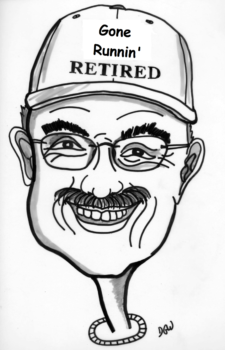On Monday, May 1, I received a text from the Marine Corps Marathon Organization. Their staff had issues measuring their May 21 race courses for USATF certification and wondered if I was available. I last measured their routes in 2013.
 I was already scheduled to work the Great Train Race and two days of track meets at Mary Wash, So I needed to do the work in the middle of the week, starting at 6 am on May 3 through 5.
I was already scheduled to work the Great Train Race and two days of track meets at Mary Wash, So I needed to do the work in the middle of the week, starting at 6 am on May 3 through 5.
With my upcoming races, I was in the middle of a taper. On May 1, my readiness score had me at 78%. This score was two days after my last long run. So, the taper was going well.
Knowing the availabilities of measurers in the area, I agreed to do the work, thinking it would take about 40 hours to complete.
On Wednesday, I did 4 hours of fieldwork on my bike. The uphills in Westwood were more challenging than I remembered. I got a few strange looks from cars going through town.
Getting up at 4 am on Thursday, I was at 28% and looking forward to the challenging rides on William Street and Cowan Boulevard. Because of traffic, I had a police escort and an MCM vehicle.
My first section was on William Street from Sunken Road to Westwood Avenue. Until I got to the Blue Gray Parkway intersection, traffic was reasonable. Then, it was the right turn and uphill on William Street toward Central Park. That was a tough hill, and I had to stop twice to get an intermediate measurement for the 5km and 3 Mile locations. I may have hit 5 miles per hour in the last section. My two support vehicles blocked traffic. The blue lights on the police car didn’t stop the honks once I turned on Westwood.
I had to do this measurement twice. We were done by 7 am. Hopefully, everyone got to work on time.
Because the Fred Nats have an afternoon game on May 21, the race finish line will be moved up the road to a tenth of a mile from Sheetz. My second measurement was on Carl Silver Parkway and Cowan Boulevard. I went from Sheetz to Hugh Mercer, then back to Sheetz.
Central Park was reasonable between 7 and 8 am, and we did not back up traffic on Cowan until I hit the final course uphill over I-95. Once again, I needed to stop twice on the uphill for 12-mile and 4-mile locations. I think I summited at 3 miles per hour.
For those who have run the event before, Mile 12 was on the overpass. This year, mile 12 will be at the bottom of the hill. Once over the top, you won’t have much distance to recover before your final sprint.
When planning my work, I knew I could not ride a straight line up Hospitalization Hill. So, it was a downhill ride.
My final work was on Caroline Street, Riverside Drive, Fall Hill Avenue, and Mary Washington Boulevard. With the assistance of Officer Bach, I could hit all the tangents safely.
Another 4 hours of riding on Thursday put my readiness score at 1% at 4 am on Friday. 1% is the lowest score possible. I received my last 1% score the day after a fast 20-mile run. I felt better the day after the 20-mile run than Friday.
I only spent 3 hours riding on Friday to determine the start location of the Semper 5 Mile and the amount of Gordon Shelton Boulevard to use for the 5 Mile portion of the Devil Dog Double. One unfortunate issue happened on Shelton when I took a tumble while stopped. The bruise is coming through. Though, it has not impacted my runs.
Saturday morning, I was at 1%. I dropped my planned 6-mile run to 4 miles. The track meet went well. However, I got a little too much sun. Sunday, I was up at 3:15 am and back to 20%. I helped at the Great Train Race until 8 am.
UMW hosted its conference track meet, and I assisted in officiating the Pole Vault and High Jump. They asked for help with the Javelin Sunday afternoon—my first time on that event. I objected to being anywhere down range.
By Monday, I was back up to 60% and am now at 77%. I spent most of Monday afternoon drawing maps. Around 7 pm, I was doing my final check on the Half-Marathon paperwork when I found a 350-foot calculation error. So, Wednesday morning, we returned at 6 am, adjusting the turnaround on Fall Hill Avenue and four mile locations.
I’m a few days from my marathon. I’ve run 13 miles in the past week and have a purple hip. My taper has gone well.
With all the turns in the marathon course, the shortest possible route is at least 400 meters shorter than the longest possible route. Running the tangents and diagonals can save you 2 to 3 minutes. Shoot for the straight-line path!
